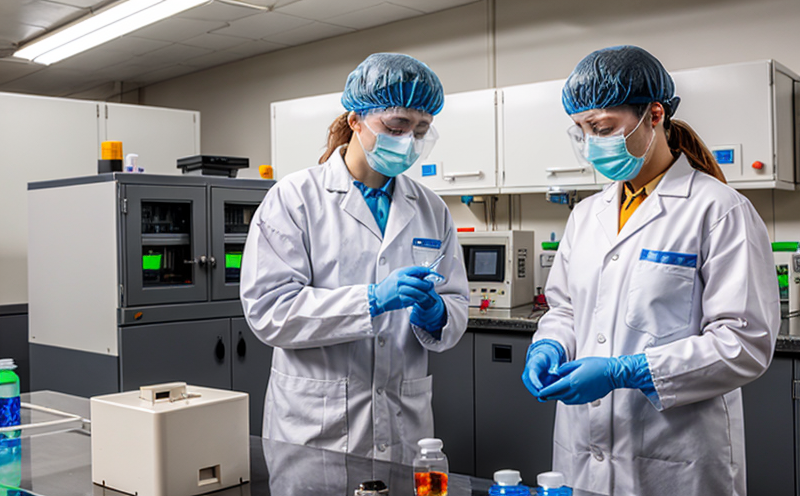ISO 24055 Glycidyl Ester Detection in Edible Oils
The detection of glycidyl ester (GE) in edible oils is a critical process for ensuring food safety and quality. ISO 24055 provides comprehensive guidelines on the quantitative determination of GE in edible fats and oils, particularly focusing on raw materials destined for human consumption.
GE is an unwanted by-product formed during the processing of vegetable oils through partial hydrogenation processes. This compound can be toxic to humans if consumed in excess, especially over long periods. Therefore, regulatory limits have been established to ensure that GE content does not exceed safe levels as per various international standards including ISO and EU regulations.
Our laboratory adheres strictly to the methods outlined in ISO 24055 for accurate detection of GE. This involves several steps starting from sample preparation which requires precise handling to avoid contamination. Following this, we use advanced analytical techniques such as High Performance Liquid Chromatography (HPLC) equipped with a Diode Array Detector (DAD), enabling us to achieve high sensitivity and specificity.
The HPLC-DAD system allows for the separation of individual components within the oil sample before quantification. This method ensures reliable results by minimizing interference from other substances present in complex matrices like vegetable oils. After analysis, our team generates detailed reports compliant with both industry best practices and relevant regulatory requirements.
Compliance with ISO 24055 is essential not only for maintaining product safety but also for protecting brand reputation against potential health risks associated with high GE levels. Our expertise extends beyond mere compliance; we offer valuable insights into process optimization aimed at reducing unwanted side products like GE during manufacturing.
In summary, our service focuses on providing accurate detection of glycidyl ester in edible oils using ISO 24055 standards. By leveraging state-of-the-art technology and adhering meticulously to specified procedures, we ensure reliable results that meet stringent quality assurance criteria set forth by relevant authorities.
- Utilization of HPLC-DAD for precise separation and quantification.
- Precision in sample preparation to prevent contamination.
- Compliance with ISO 24055 guidelines throughout the testing process.
- Detailed reporting aligned with regulatory expectations.
Scope and Methodology
The scope of our service revolves around detecting glycidyl ester (GE) in edible oils using ISO 24055 standards. This involves multiple stages aimed at achieving accurate and reliable results.
Firstly, we ensure proper sample collection and preparation which includes homogenization to obtain a representative sample. This step is crucial as it prevents any bias that could affect the accuracy of subsequent analyses.
The next stage entails extraction of GE from the oil matrix using appropriate solvents followed by purification steps if necessary. These procedures aim at isolating only the target compound while eliminating interferences from other components.
Following this, the purified sample undergoes injection into an HPLC-DAD instrument for analysis. During this process, we carefully monitor parameters like flow rate and column temperature to optimize separation efficiency. The DAD provides additional information about GE by measuring its absorbance across multiple wavelengths simultaneously.
The final step in our methodology involves interpretation of the chromatographic peaks obtained from HPLC-DAD output against calibration curves prepared previously. Based on these interpretations, we calculate concentrations of GE present in the sample and compare them against established limits prescribed by international standards.
Quality and Reliability Assurance
To ensure the highest level of quality and reliability in our testing services, we implement stringent quality control measures throughout every stage of the process. Our commitment to accuracy is reflected through meticulous adherence to ISO 24055 standards.
We employ rigorous validation protocols for all analytical methods used, ensuring consistent performance across multiple runs. This includes regular calibration checks and proficiency testing against certified reference materials provided by recognized organizations like NIST or BCR.
Our technicians undergo continuous training to stay updated with the latest developments in analytical science pertinent to glycidyl ester detection. They participate actively in inter-laboratory comparisons organized under auspices of bodies such as AOAC International or AFNOR, further enhancing our credibility and trustworthiness.
In addition to these internal controls, we maintain ISO 17025 accreditation which signifies our laboratory's ability to meet high scientific standards required for accurate testing. This certification guarantees that our methodologies are robust enough to provide reliable outputs meeting the stringent demands of regulatory bodies worldwide.
Use Cases and Application Examples
Detecting glycidyl ester in edible oils is relevant across various sectors including food production, retail, and regulation enforcement. Here are some practical applications:
- R&D Engineers: Use our service to identify sources of GE formation during processing stages, aiding in process optimization.
- Quality Managers: Monitor ongoing compliance with regulatory limits ensuring consumer safety and brand integrity.
- Compliance Officers: Stay ahead of new regulations by continuously assessing product quality through rigorous testing.
- Procurement Teams: Verify supplier reliability by validating GE content in incoming batches against specified thresholds.
Our service plays a pivotal role in safeguarding public health while supporting sustainable business practices within the food industry. By providing reliable data, we empower stakeholders to make informed decisions that contribute towards safer and healthier consumption habits worldwide.





